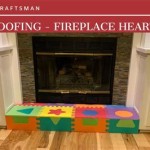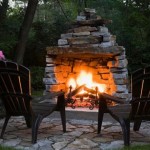Selecting Tiles for a Fireplace Hearth: A Comprehensive Guide
The fireplace hearth serves as a critical element in both the functional and aesthetic design of a fireplace. It provides a non-combustible barrier between the fireplace opening and the surrounding flooring, safeguarding against embers and heat transfer. The selection of appropriate tiles for the hearth is therefore a decision that necessitates careful consideration of safety requirements, durability, and visual appeal. This article will delve into the key factors involved in choosing tiles for a fireplace hearth, providing a comprehensive overview to assist homeowners and designers in making informed decisions.
The primary purpose of a fireplace hearth is safety. It is designed to prevent combustible materials, such as carpets or wooden flooring, from catching fire due to stray embers or radiant heat emanating from the fireplace. Building codes often specify minimum hearth dimensions and materials to ensure adequate fire protection. Generally, the hearth should extend a certain distance in front of the fireplace opening and to the sides, as dictated by local regulations. Failure to comply with these regulations can pose a significant safety hazard and may be grounds for failing a home inspection.
Beyond its functional role, the hearth contributes significantly to the overall aesthetic of the fireplace and the room. The tile choice can either blend seamlessly with the existing decor or serve as a focal point, adding character and visual interest to the space. With a vast array of tile options available in terms of material, color, pattern, and size, the possibilities for creating a unique and stylish hearth are virtually limitless.
Understanding Tile Materials and Their Properties
The selection of tile material is paramount when designing a fireplace hearth. Certain materials are better suited to withstand the extreme temperatures and potential impact associated with fireplace use. The following are some of the most common and suitable tile materials, each possessing distinct advantages and disadvantages:
Ceramic Tiles: Ceramic tiles are a popular choice for fireplace hearths due to their affordability, versatility, and ease of maintenance. They consist of clay that has been fired at high temperatures. Ceramic tiles are generally durable and resistant to stains and scratches, however, their heat resistance varies depending on the specific type of ceramic. It's vital to select ceramic tiles that are specifically rated for fireplace applications, ensuring they can withstand the heat without cracking or warping. Porcelain tiles, a subset of ceramic tiles, are generally denser and more durable than non-porcelain ceramic tiles. They are also less porous, making them more resistant to moisture and stains. This makes porcelain a superior choice for hearths subjected to spills or moisture exposure from fireplace cleaning.
Porcelain Tiles: As mentioned above, porcelain tiles are a denser, more durable type of ceramic tile. This increased density results in superior heat resistance and lower water absorption. Porcelain tiles are typically more expensive than standard ceramic tiles, but their enhanced performance and longevity often justify the higher cost, especially in high-heat areas like a fireplace hearth. They are available in a wide range of colors, patterns, and sizes, including options that mimic natural stone, offering design flexibility without sacrificing durability.
Stone Tiles: Natural stone tiles, such as granite, marble, slate, and travertine, offer a timeless and elegant aesthetic for a fireplace hearth. Each type of stone possesses unique characteristics in terms of color, texture, and veining, adding a natural and distinctive touch to the space. Granite is a particularly durable and heat-resistant option, making it well-suited for high-heat applications. Marble, while visually appealing, is more porous than granite and may be more susceptible to staining. Slate offers a rustic and textured appearance and is also known for its durability and heat resistance. Travertine features a distinctive pitted surface and warm tones, but it requires sealing to protect it from staining and moisture absorption. When using natural stone, it's essential to properly seal the tiles to prevent staining and to enhance their longevity.
Quarry Tiles: Quarry tiles are another robust option, made from a blend of clay and shale. They are known for their exceptional durability, heat resistance, and slip resistance, making them a practical choice for a fireplace hearth. Quarry tiles typically have a rustic appearance and earthy tones, which can complement a variety of design styles. Their low absorption rate also makes them resistant to staining and moisture damage.
Glass Tiles: While primarily used for decorative accents, glass tiles can be incorporated into a fireplace hearth design, often as part of a mosaic or border. However, it is important to note that not all glass tiles are suitable for high-heat applications. Consult with a tile professional to ensure that the selected glass tiles are heat-resistant and can withstand the temperatures associated with fireplace use. Furthermore, glass tiles can be more susceptible to scratching and chipping than other tile materials.
When evaluating tile materials, consider the overall style of the room, the level of heat exposure the hearth will endure, and the desired maintenance requirements. Selecting a material that balances aesthetic appeal with durability and safety is crucial for a successful fireplace hearth installation.
Considering Size, Shape and Layout
The size, shape, and layout of the tiles significantly influence the overall appearance of the fireplace hearth. These elements can be used to create a variety of visual effects, from a classic and traditional look to a modern and contemporary design.
Tile Size: Larger tiles create a more streamlined and contemporary look, minimizing grout lines and making the hearth appear more spacious. Smaller tiles, on the other hand, can add texture and visual interest, especially when arranged in intricate patterns. Mosaic tiles, consisting of very small pieces, offer endless possibilities for creating custom designs and adding a unique artistic touch to the hearth. The size of the tiles should also be proportionate to the size of the fireplace and the room. Overly large tiles in a small space can overwhelm the area, while excessively small tiles in a large space may appear disjointed.
Tile Shape: Traditional square and rectangular tiles are a classic choice, providing a clean and versatile look. However, other shapes, such as hexagonal, octagonal, or even circular tiles, can add a distinctive and eye-catching element to the hearth. Consider the overall architectural style of the room when selecting the tile shape. Geometric shapes often complement modern designs, while more organic shapes may be more appropriate for rustic or traditional settings.
Tile Layout: The layout of the tiles can dramatically alter the appearance of the hearth. A standard grid pattern provides a clean and orderly look, while a staggered or offset pattern can add visual interest and a more casual feel. Herringbone and chevron patterns create a sophisticated and elegant effect. For a more contemporary look, consider using a random pattern with tiles of varying sizes and shapes. The grout lines also play a significant role in the overall layout. Using a contrasting grout color can accentuate the tiles and create a bolder statement, while a matching grout color provides a more seamless and subtle look.
Carefully considering the size, shape, and layout of the tiles allows for the creation of a fireplace hearth that complements the surrounding environment and enhances the overall aesthetic of the room. A well-planned layout can also minimize waste and reduce installation time.
Installation and Maintenance
Proper installation is crucial for ensuring the safety, durability, and longevity of a fireplace hearth. Incorrect installation can lead to cracks, loose tiles, and potentially hazardous conditions. It is highly recommended to hire a qualified and experienced tile installer for this task. The installer will ensure that the subfloor is properly prepared, the tiles are correctly aligned, and the appropriate adhesives and grouts are used.
Subfloor Preparation: A stable and level subfloor is essential for a successful tile installation. The subfloor should be clean, dry, and free of any debris. If the subfloor is uneven or damaged, it may need to be repaired or replaced before the tiles can be installed. A cement board underlayment is often used to provide a smooth and stable surface for the tiles.
Adhesives and Grouts: Selecting the correct adhesives and grouts is critical for ensuring a long-lasting and durable hearth. Use adhesives and grouts specifically designed for tile installations and suitable for high-heat applications. Follow the manufacturer's instructions carefully when mixing and applying these materials. Epoxy grouts are generally more durable and stain-resistant than cement-based grouts, making them a good choice for fireplace hearths.
Sealing: Natural stone tiles, in particular, require sealing to protect them from staining and moisture absorption. Apply a high-quality penetrating sealer to the tiles before grouting and then again after grouting. This will help to prevent stains and make the tiles easier to clean. Reapply the sealer periodically, as needed, to maintain their protective properties.
Maintenance: Regular cleaning and maintenance will help to keep the fireplace hearth looking its best and extend its lifespan. Sweep or vacuum the hearth regularly to remove dust and debris. Clean spills and stains promptly with a mild detergent and water. Avoid using harsh chemicals or abrasive cleaners, as these can damage the tile surface. Inspect the grout lines periodically for cracks or damage and repair them as needed.
Investing in proper installation and adhering to a regular maintenance schedule will ensure that the fireplace hearth remains a beautiful and functional element of the home for years to come.
In conclusion, choosing the right tiles for a fireplace hearth involves a multifaceted approach, balancing safety considerations with aesthetic desires. By carefully evaluating the material properties, size, shape, and installation requirements, homeowners and designers can create a hearth that is both visually appealing and provides reliable fire protection.

Fireplace Tiles Fire Surround Hearth

Tile Inspiration For Fireplaces And Hearths The Otto House

Fireplaces Renditions Tiles

Handmade Fireplace Tiles Bert May

What Are The Best Tiles For A Fireplace Rotherham Centre

Fireplace Hearths And Wall Tiles Period Floors

Fireplace Tiles Classique Floors Tile Portland Or

Hearth Olde English Tiles

How To Remove Quarry Tile Level New Tiles

How To Tile A Fireplace My Uncommon Slice Of Suburbia
Related Posts








